Abstract
We investigated the ability of staphylococcal enterotoxins A and B, exfoliative toxins A and B, and toxic shock syndrome toxin 1 to activate macrophages. All of the toxins tested had the potential to stimulate tumoricidal activity in peritoneal macrophages from lipopolysaccharide-responsive C3HeB/FeJ mice. In contrast, none of the toxins activated cytotoxicity in lipopolysaccharide-unresponsive macrophages from C3H/HeJ mice. We also studied toxin stimulation of monokine secretion. Staphylococcal enterotoxin A, toxic shock syndrome toxin 1, and both exfoliative toxins triggered C3HeB/FeJ macrophages to secrete tumor necrosis factor alpha, but enterotoxin B induced only marginal amounts of tumor necrosis factor. All of the toxins used stimulated interleukin-6 production by macrophages from both strains of mice. Nitric oxide is produced in response to the exfoliative toxins only by the lipopolysaccharide-responsive macrophages. These results suggest that macrophages respond differently to several staphylococcal exotoxins.
Full text
PDF
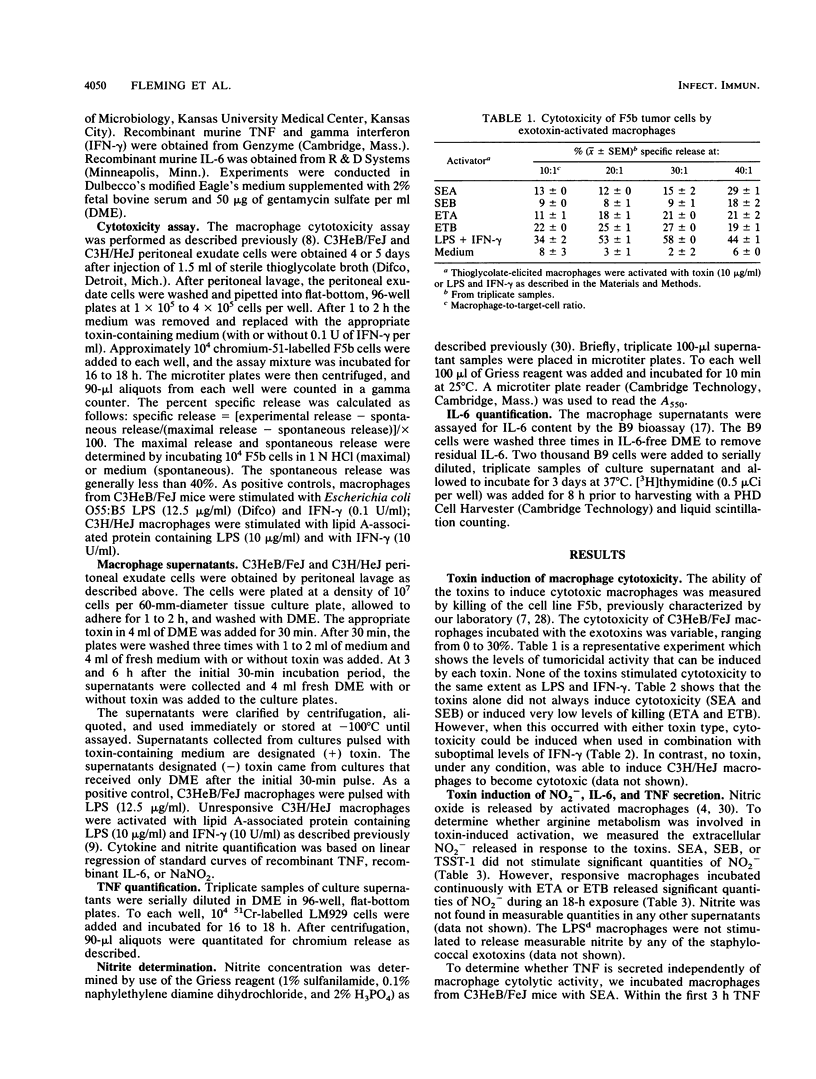
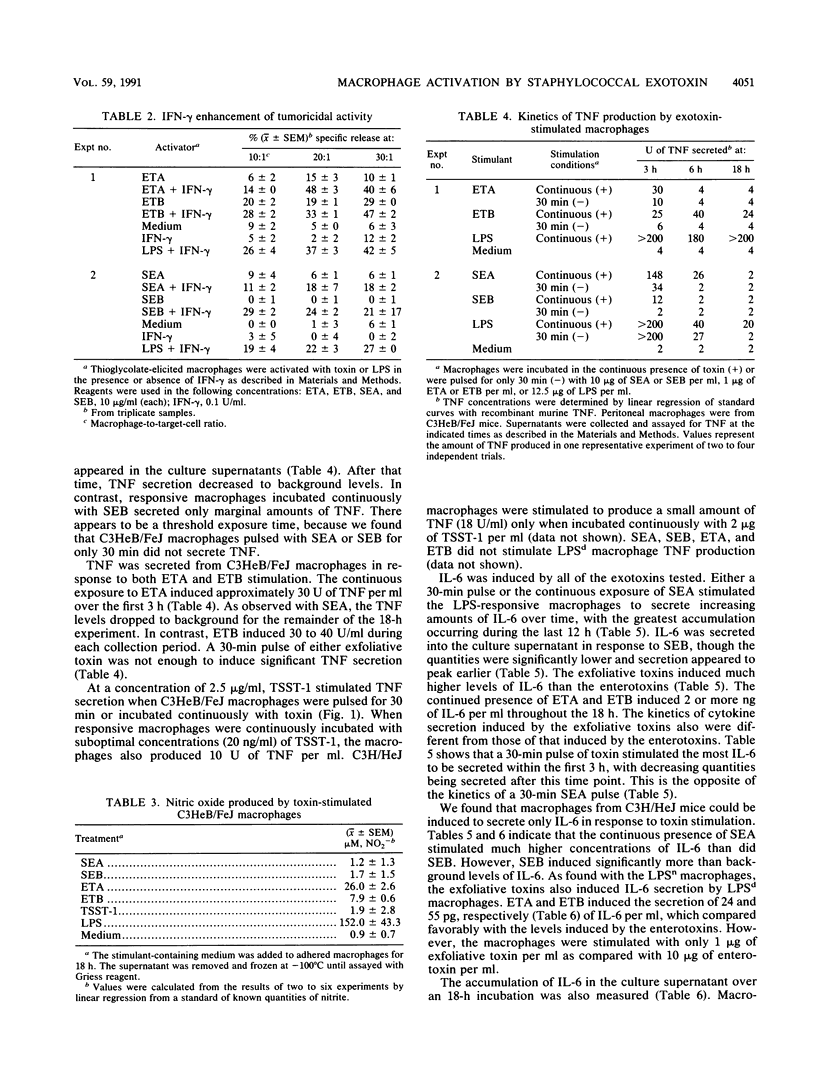
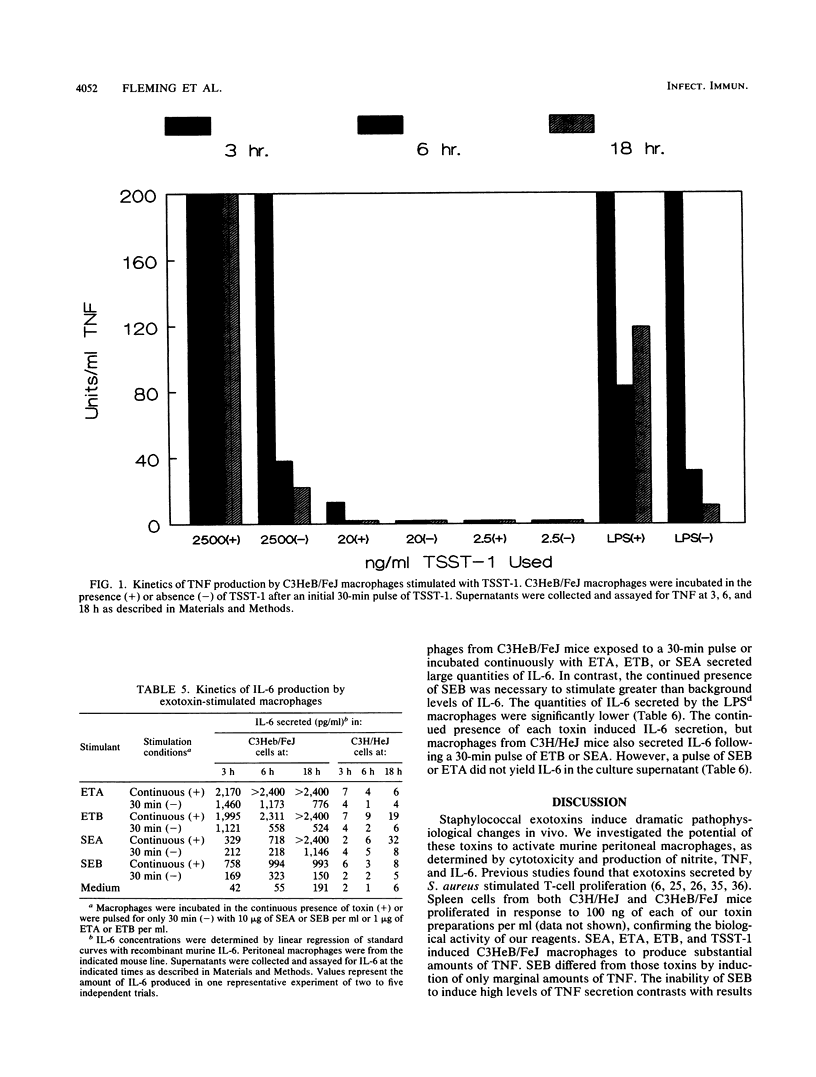
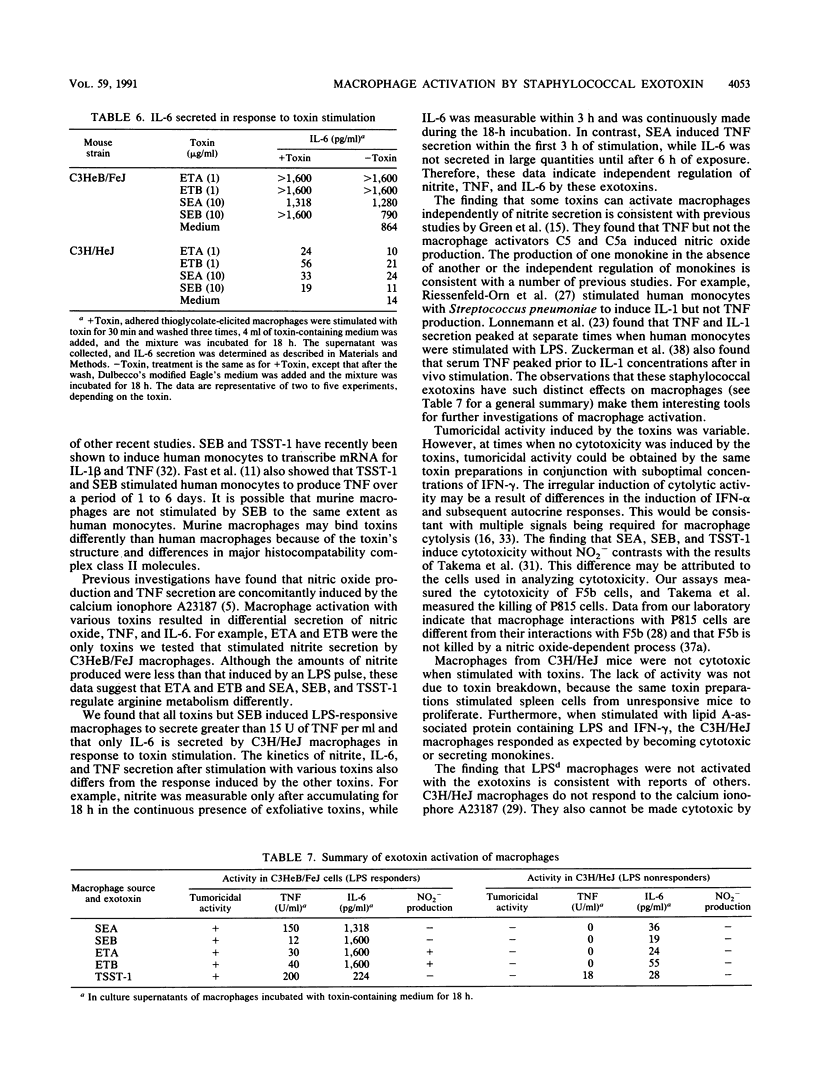
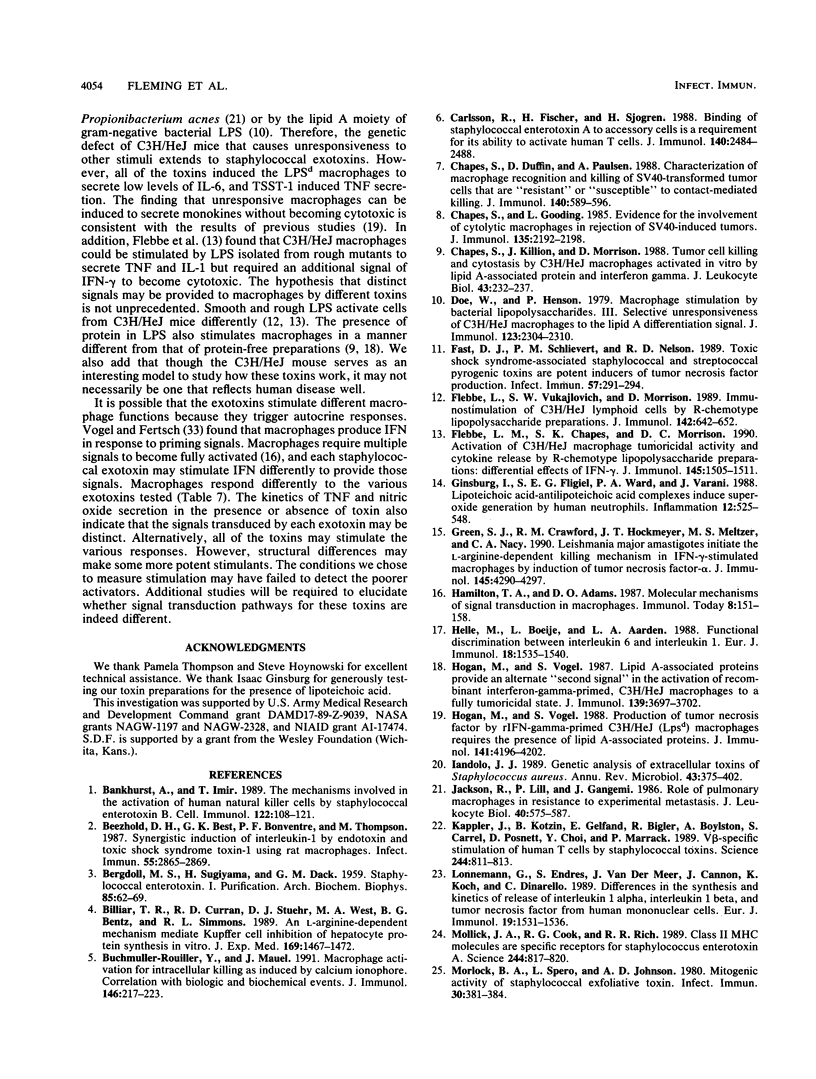
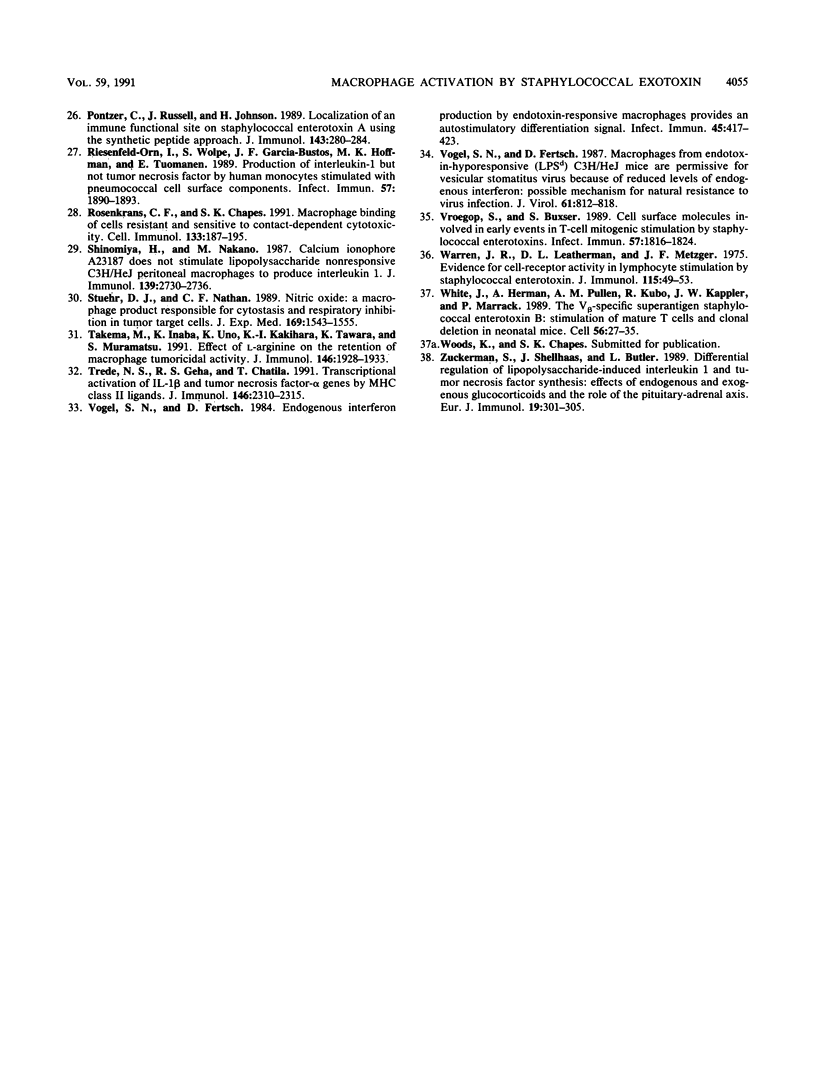
Selected References
These references are in PubMed. This may not be the complete list of references from this article.
- BERGDOLL M. S., SUGIYAMA H., DACK G. M. Staphylococcal enterotoxin. I. Purification. Arch Biochem Biophys. 1959 Nov;85:62–69. doi: 10.1016/0003-9861(59)90447-3. [DOI] [PubMed] [Google Scholar]
- Bankhurst A. D., Imir T. The mechanisms involved in the activation of human natural killer cells by staphylococcal enterotoxin B. Cell Immunol. 1989 Aug;122(1):108–121. doi: 10.1016/0008-8749(89)90152-4. [DOI] [PubMed] [Google Scholar]
- Beezhold D. H., Best G. K., Bonventre P. F., Thompson M. Synergistic induction of interleukin-1 by endotoxin and toxic shock syndrome toxin-1 using rat macrophages. Infect Immun. 1987 Dec;55(12):2865–2869. doi: 10.1128/iai.55.12.2865-2869.1987. [DOI] [PMC free article] [PubMed] [Google Scholar]
- Billiar T. R., Curran R. D., Stuehr D. J., West M. A., Bentz B. G., Simmons R. L. An L-arginine-dependent mechanism mediates Kupffer cell inhibition of hepatocyte protein synthesis in vitro. J Exp Med. 1989 Apr 1;169(4):1467–1472. doi: 10.1084/jem.169.4.1467. [DOI] [PMC free article] [PubMed] [Google Scholar]
- Buchmüller-Rouiller Y., Mauël J. Macrophage activation for intracellular killing as induced by calcium ionophore. Correlation with biologic and biochemical events. J Immunol. 1991 Jan 1;146(1):217–223. [PubMed] [Google Scholar]
- Carlsson R., Fischer H., Sjögren H. O. Binding of staphylococcal enterotoxin A to accessory cells is a requirement for its ability to activate human T cells. J Immunol. 1988 Apr 15;140(8):2484–2488. [PubMed] [Google Scholar]
- Chapes S. K., Duffin D., Paulsen A. Q. Characterization of macrophage recognition and killing of SV40-transformed tumor cells that are "resistant" or "susceptible" to contact-mediated killing. J Immunol. 1988 Jan 15;140(2):589–596. [PubMed] [Google Scholar]
- Chapes S. K., Gooding L. R. Evidence for the involvement of cytolytic macrophages in rejection of SV40-induced tumors. J Immunol. 1985 Sep;135(3):2192–2198. [PubMed] [Google Scholar]
- Chapes S. K., Killion J. W., Morrison D. C. Tumor cell killing and cytostasis by C3H/HeJ macrophages activated in vitro by lipid A-associated protein and interferon gamma. J Leukoc Biol. 1988 Mar;43(3):232–237. doi: 10.1002/jlb.43.3.232. [DOI] [PubMed] [Google Scholar]
- Doe W. F., Henson P. M. Macrophage stimulation by bacterial lipopolysaccharides. III. Selective unresponsiveness of C3H/HeJ macrophages to the lipid A differentiation signal. J Immunol. 1979 Nov;123(5):2304–2310. [PubMed] [Google Scholar]
- Fast D. J., Schlievert P. M., Nelson R. D. Toxic shock syndrome-associated staphylococcal and streptococcal pyrogenic toxins are potent inducers of tumor necrosis factor production. Infect Immun. 1989 Jan;57(1):291–294. doi: 10.1128/iai.57.1.291-294.1989. [DOI] [PMC free article] [PubMed] [Google Scholar]
- Flebbe L. M., Chapes S. K., Morrison D. C. Activation of C3H/HeJ macrophage tumoricidal activity and cytokine release by R-chemotype lipopolysaccharide preparations. Differential effects of IFN-gamma. J Immunol. 1990 Sep 1;145(5):1505–1511. [PubMed] [Google Scholar]
- Flebbe L., Vukajlovich S. W., Morrison D. C. Immunostimulation of C3H/HeJ lymphoid cells by R-chemotype lipopolysaccharide preparations. J Immunol. 1989 Jan 15;142(2):642–652. [PubMed] [Google Scholar]
- Ginsburg I., Fligiel S. E., Ward P. A., Varani J. Lipoteichoic acid-antilipoteichoic acid complexes induce superoxide generation by human neutrophils. Inflammation. 1988 Dec;12(6):525–548. doi: 10.1007/BF00914316. [DOI] [PubMed] [Google Scholar]
- Green S. J., Crawford R. M., Hockmeyer J. T., Meltzer M. S., Nacy C. A. Leishmania major amastigotes initiate the L-arginine-dependent killing mechanism in IFN-gamma-stimulated macrophages by induction of tumor necrosis factor-alpha. J Immunol. 1990 Dec 15;145(12):4290–4297. [PubMed] [Google Scholar]
- Helle M., Boeije L., Aarden L. A. Functional discrimination between interleukin 6 and interleukin 1. Eur J Immunol. 1988 Oct;18(10):1535–1540. doi: 10.1002/eji.1830181010. [DOI] [PubMed] [Google Scholar]
- Hogan M. M., Vogel S. N. Lipid A-associated proteins provide an alternate "second signal" in the activation of recombinant interferon-gamma-primed, C3H/HeJ macrophages to a fully tumoricidal state. J Immunol. 1987 Dec 1;139(11):3697–3702. [PubMed] [Google Scholar]
- Hogan M. M., Vogel S. N. Production of tumor necrosis factor by rIFN-gamma-primed C3H/HeJ (Lpsd) macrophages requires the presence of lipid A-associated proteins. J Immunol. 1988 Dec 15;141(12):4196–4202. [PubMed] [Google Scholar]
- Iandolo J. J. Genetic analysis of extracellular toxins of Staphylococcus aureus. Annu Rev Microbiol. 1989;43:375–402. doi: 10.1146/annurev.mi.43.100189.002111. [DOI] [PubMed] [Google Scholar]
- Jackson R. A., Lill P. H., Gangemi J. D. Role of pulmonary macrophages in resistance to experimental metastasis. J Leukoc Biol. 1986 Nov;40(5):575–587. doi: 10.1002/jlb.40.5.575. [DOI] [PubMed] [Google Scholar]
- Kappler J., Kotzin B., Herron L., Gelfand E. W., Bigler R. D., Boylston A., Carrel S., Posnett D. N., Choi Y., Marrack P. V beta-specific stimulation of human T cells by staphylococcal toxins. Science. 1989 May 19;244(4906):811–813. doi: 10.1126/science.2524876. [DOI] [PubMed] [Google Scholar]
- Lonnemann G., Endres S., Van der Meer J. W., Cannon J. G., Koch K. M., Dinarello C. A. Differences in the synthesis and kinetics of release of interleukin 1 alpha, interleukin 1 beta and tumor necrosis factor from human mononuclear cells. Eur J Immunol. 1989 Sep;19(9):1531–1536. doi: 10.1002/eji.1830190903. [DOI] [PubMed] [Google Scholar]
- Mollick J. A., Cook R. G., Rich R. R. Class II MHC molecules are specific receptors for staphylococcus enterotoxin A. Science. 1989 May 19;244(4906):817–820. doi: 10.1126/science.2658055. [DOI] [PubMed] [Google Scholar]
- Morlock B. A., Spero L., Johnson A. D. Mitogenic activity of staphylococcal exfoliative toxin. Infect Immun. 1980 Nov;30(2):381–384. doi: 10.1128/iai.30.2.381-384.1980. [DOI] [PMC free article] [PubMed] [Google Scholar]
- Pontzer C. H., Russell J. K., Johnson H. M. Localization of an immune functional site on staphylococcal enterotoxin A using the synthetic peptide approach. J Immunol. 1989 Jul 1;143(1):280–284. [PubMed] [Google Scholar]
- Riesenfeld-Orn I., Wolpe S., Garcia-Bustos J. F., Hoffmann M. K., Tuomanen E. Production of interleukin-1 but not tumor necrosis factor by human monocytes stimulated with pneumococcal cell surface components. Infect Immun. 1989 Jul;57(7):1890–1893. doi: 10.1128/iai.57.7.1890-1893.1989. [DOI] [PMC free article] [PubMed] [Google Scholar]
- Rosenkrans C. F., Jr, Chapes S. K. Macrophage binding of cells resistant and sensitive to contact-dependent cytotoxicity. Cell Immunol. 1991 Mar;133(1):187–195. doi: 10.1016/0008-8749(91)90190-m. [DOI] [PubMed] [Google Scholar]
- Shinomiya H., Nakano M. Calcium ionophore A23187 does not stimulate lipopolysaccharide nonresponsive C3H/HeJ peritoneal macrophages to produce interleukin 1. J Immunol. 1987 Oct 15;139(8):2730–2736. [PubMed] [Google Scholar]
- Stuehr D. J., Nathan C. F. Nitric oxide. A macrophage product responsible for cytostasis and respiratory inhibition in tumor target cells. J Exp Med. 1989 May 1;169(5):1543–1555. doi: 10.1084/jem.169.5.1543. [DOI] [PMC free article] [PubMed] [Google Scholar]
- Takema M., Inaba K., Uno K., Kakihara K., Tawara K., Muramatsu S. Effect of L-arginine on the retention of macrophage tumoricidal activity. J Immunol. 1991 Mar 15;146(6):1928–1933. [PubMed] [Google Scholar]
- Trede N. S., Geha R. S., Chatila T. Transcriptional activation of IL-1 beta and tumor necrosis factor-alpha genes by MHC class II ligands. J Immunol. 1991 Apr 1;146(7):2310–2315. [PubMed] [Google Scholar]
- Vogel S. N., Fertsch D. Endogenous interferon production by endotoxin-responsive macrophages provides an autostimulatory differentiation signal. Infect Immun. 1984 Aug;45(2):417–423. doi: 10.1128/iai.45.2.417-423.1984. [DOI] [PMC free article] [PubMed] [Google Scholar]
- Vogel S. N., Fertsch D. Macrophages from endotoxin-hyporesponsive (Lpsd) C3H/HeJ mice are permissive for vesicular stomatitis virus because of reduced levels of endogenous interferon: possible mechanism for natural resistance to virus infection. J Virol. 1987 Mar;61(3):812–818. doi: 10.1128/jvi.61.3.812-818.1987. [DOI] [PMC free article] [PubMed] [Google Scholar]
- Vroegop S. M., Buxser S. E. Cell surface molecules involved in early events in T-cell mitogenic stimulation by staphylococcal enterotoxins. Infect Immun. 1989 Jun;57(6):1816–1824. doi: 10.1128/iai.57.6.1816-1824.1989. [DOI] [PMC free article] [PubMed] [Google Scholar]
- Warren J. R., Leatherman D. L., Metzger J. F. Evidence for cell-receptor activity in lymphocyte stimulation by staphylococcal enterotoxin. J Immunol. 1975 Jul;115(1):49–53. [PubMed] [Google Scholar]
- White J., Herman A., Pullen A. M., Kubo R., Kappler J. W., Marrack P. The V beta-specific superantigen staphylococcal enterotoxin B: stimulation of mature T cells and clonal deletion in neonatal mice. Cell. 1989 Jan 13;56(1):27–35. doi: 10.1016/0092-8674(89)90980-x. [DOI] [PubMed] [Google Scholar]
- Zuckerman S. H., Shellhaas J., Butler L. D. Differential regulation of lipopolysaccharide-induced interleukin 1 and tumor necrosis factor synthesis: effects of endogenous and exogenous glucocorticoids and the role of the pituitary-adrenal axis. Eur J Immunol. 1989 Feb;19(2):301–305. doi: 10.1002/eji.1830190213. [DOI] [PubMed] [Google Scholar]


